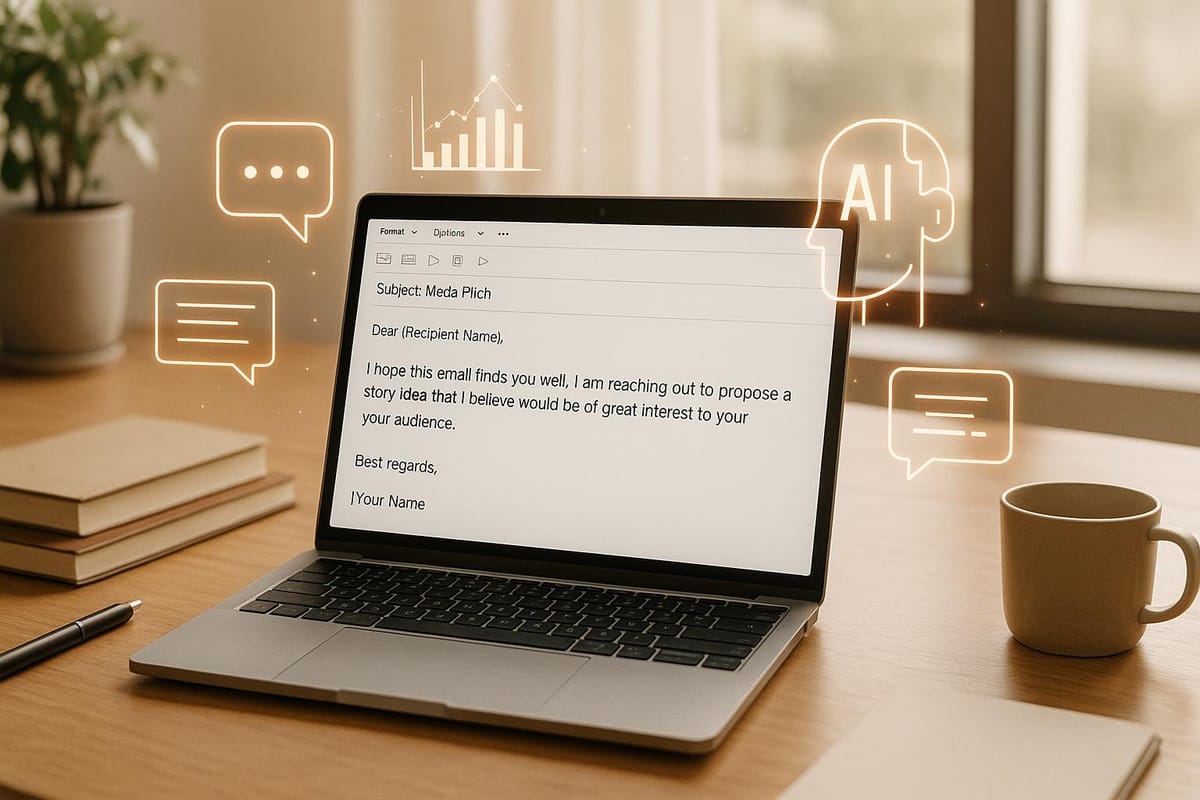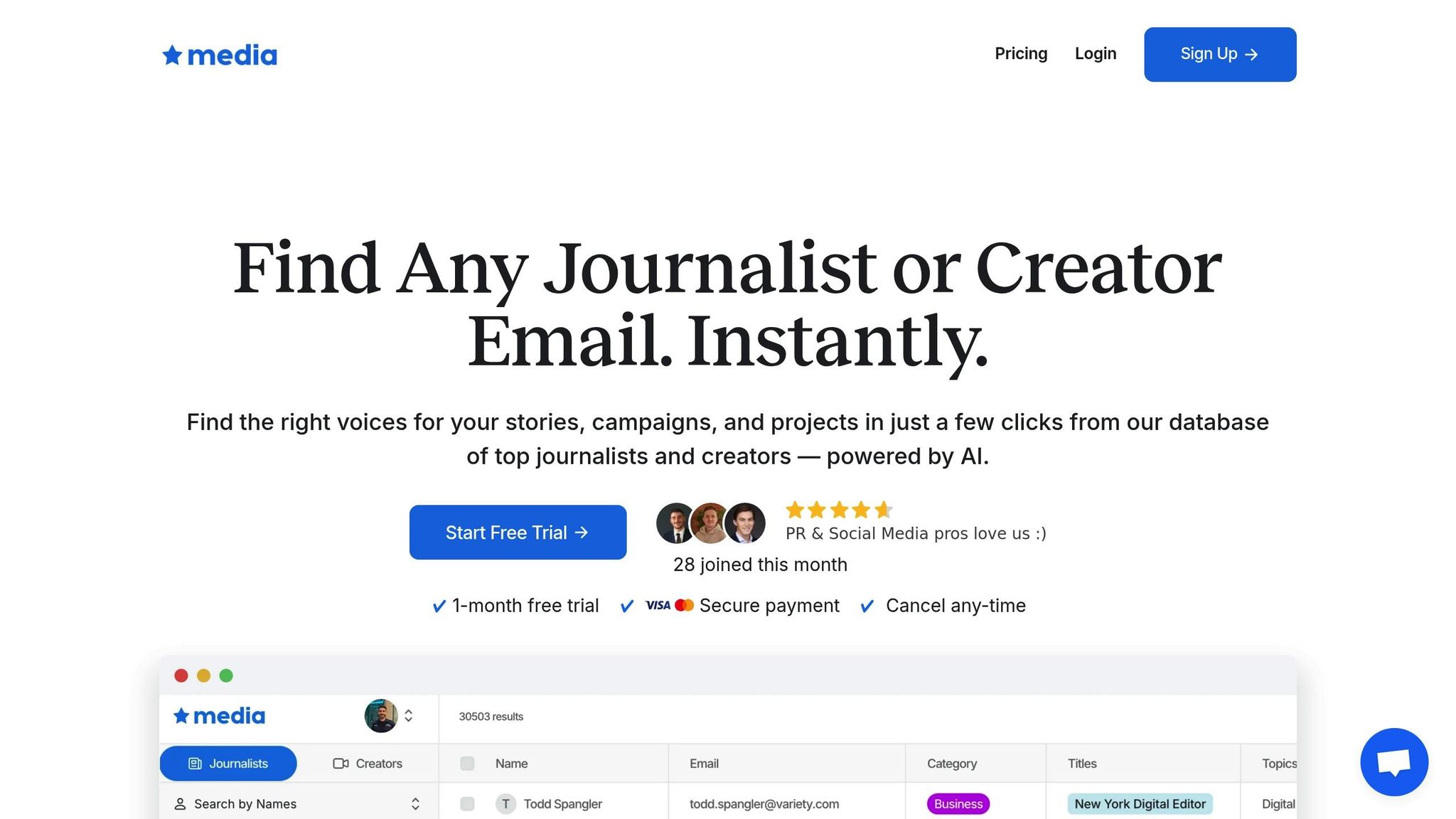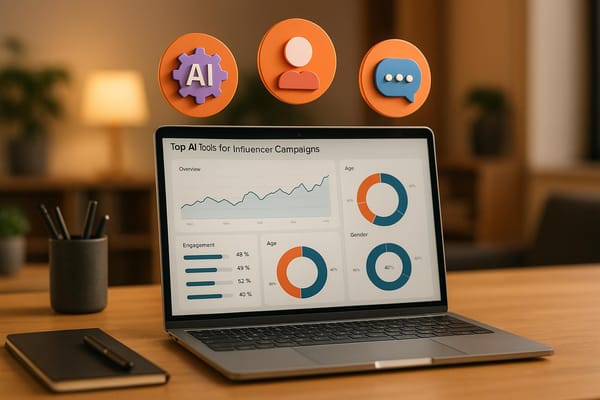AI in Media Relations: Common Challenges Solved
Explore how AI is transforming media relations by streamlining tasks, enhancing personalization, and fostering stronger journalist connections.

AI is reshaping media relations by automating tedious tasks and providing data-driven insights, helping PR professionals work smarter, not harder. It simplifies finding journalists, personalizing outreach, tracking media coverage, and managing relationships - areas that have traditionally been time-consuming and prone to error. Here's how:
- Finding Journalists and Creators: AI tools quickly identify relevant contacts by analyzing writing patterns, engagement metrics, and niche expertise.
- Personalized Outreach: AI scales personalization by suggesting tailored pitches based on a journalist's preferences and past work.
- Media Monitoring and Sentiment Analysis: Real-time tracking and sentiment analysis help PR teams respond faster and understand coverage impact.
- Maintaining Relationships: Automated updates of contact information ensure PR teams stay connected despite high journalist turnover.
Tools like Media AI simplify these processes with features like advanced search, real-time database updates, and affordable pricing (starting at $99/month). By combining AI's efficiency with human judgment, PR teams can focus on meaningful connections and better outcomes.
AI & PR: How AI is Changing Public Relations (Without Replacing Humans!)
Common Challenges in Media Relations
Media relations is undeniably vital, but it comes with its fair share of obstacles. As the media landscape becomes more intricate and competitive, PR professionals face an uphill battle. These hurdles highlight the need for smarter, more efficient solutions, such as AI, to simplify and enhance the process.
Finding the Right Journalists and Creators
One of the biggest headaches in media relations is identifying the right people to contact. PR teams often spend countless hours sifting through fragmented databases filled with outdated information. Journalists frequently switch beats, publications, or even industries, making it a constant challenge to keep contact lists accurate. This issue becomes even more pronounced when trying to connect with rising voices like newsletter writers, podcast hosts, or LinkedIn influencers.
The growing creator economy adds yet another layer of complexity. Traditional media databases tend to focus on established journalists, leaving out key players like YouTube creators or independent content producers. PR professionals often have to start from scratch, manually researching these emerging voices for every new campaign.
Geography and niche expertise further complicate the search. For instance, a PR team working on a fintech story might need to find journalists who specialize in both financial technology and specific areas like cryptocurrency or lending. This level of specialization requires a deep understanding of local media landscapes, which is hard to achieve using conventional tools.
Personalizing Outreach at Scale
Balancing personalization and scale is another major challenge. Crafting tailored pitches for large media lists is time-consuming, leaving PR professionals stuck between reaching a broader audience or sending more relevant, customized messages.
Personalized outreach often leads to better response rates, but the process is labor-intensive. Researching a journalist’s style, interests, and recent work can take more than 10 minutes per contact. Multiply that by dozens or even hundreds of contacts, and the workload quickly becomes unmanageable - especially when juggling multiple campaigns.
The problem grows when PR teams handle several clients or products at once. Each campaign demands unique messaging and targets different audiences. Keeping track of who has been contacted, their preferences, and their history of coverage can feel like an organizational nightmare.
Managing Media Monitoring and Sentiment Analysis
Monitoring media mentions across various platforms is another uphill task. Without advanced tools, tracking thousands of mentions manually can lead to delays and missed opportunities for timely responses. Real-time monitoring, paired with sentiment analysis, is essential for understanding how coverage impacts a brand.
Sentiment analysis, however, is far from straightforward. A mention might seem positive at first glance but could include subtle criticism or skepticism that affects public perception. Analyzing these nuances requires context and a careful eye - something that’s hard to scale when dealing with hundreds of daily mentions.
The challenge doesn’t stop at tracking your own coverage. PR teams also need to monitor competitors, industry trends, and emerging topics that could influence their clients. This broad scope multiplies the data volume, making manual analysis nearly impossible. AI tools can now step in to provide real-time monitoring and sentiment analysis, helping PR teams manage this overwhelming workload.
Building and Maintaining Long-Term Media Relationships
Maintaining strong media relationships is no small feat, especially with high journalist turnover and constant beat changes. PR teams often find themselves starting over, rebuilding connections from scratch when contacts shift to new roles or industries.
For example, a journalist covering technology might suddenly move to healthcare, rendering previous relationship efforts less effective. Keeping track of these changes across hundreds of contacts can feel like a full-time job.
Adding to the challenge, journalists today face tighter deadlines and heavier workloads. Building lasting relationships requires PR professionals to offer consistent value - whether through exclusive insights, expert sources, or compelling story angles. Delivering this level of value across dozens or even hundreds of media contacts demands significant time and resources, making it a daunting but necessary task.
AI-Powered Solutions to Media Relations Challenges
AI is reshaping media relations by simplifying tasks that used to overwhelm PR professionals. With today’s AI platforms, processes like finding journalists and keeping media lists accurate are no longer tedious and time-consuming - they’ve become efficient and data-driven.
Automated Journalist and Creator Discovery
Finding the right media contacts has always been a critical part of PR, but AI tools have made it faster and more precise. These platforms can analyze massive databases in seconds, identifying the most relevant journalists and creators for a given campaign.
Take Media AI, for example. It boasts a database of over 30,000 journalists and creators, offering powerful filtering options to refine searches by beat, publication type, location, and audience size. This means PR teams can skip the guesswork and focus on connecting with the right people, saving hours of effort.
What’s more, Media AI recognizes the growing influence of creators alongside traditional journalists. By including both in one platform, it bridges the gap between old and new media. Plus, its database updates in real time, reflecting changes in roles and beats so media lists stay accurate and up-to-date.
But AI doesn’t stop at discovery - it also helps build lasting connections.
Sustaining Media Relationships Over Time
Keeping media lists accurate is a constant challenge, but Media AI makes it easier by automatically updating contact information. This ensures PR professionals always have the latest details, allowing them to focus on building meaningful, long-term relationships instead of wasting time on manual updates.
With tools like these, PR teams can shift their energy from administrative tasks to fostering genuine connections with journalists and creators, ensuring their media strategies remain effective and relevant.
Why Media AI Stands Out in the Market

Media AI offers a straightforward and affordable solution tailored specifically for U.S. PR professionals. By focusing on practicality and ease of use rather than overwhelming enterprise-level features, it’s a perfect fit for startups, freelancers, and small agencies. Here’s how Media AI delivers on its promises.
A Look at Media AI’s Features
Media AI tackles the problem of scattered media data with an AI-driven database of over 30,000 journalists and creators. With tools like advanced search, seamless filtering, export options, and regularly updated contact information, it simplifies the day-to-day tasks of PR professionals. Its pricing, starting at just $99 and capping at $149 per month, is designed to be accessible, with no long-term contracts required - making professional tools available to teams of all sizes.
Benefits Tailored to U.S. PR Professionals
Media AI’s no-contract pricing model is ideal for project-based or budget-conscious PR teams. The platform’s intuitive design shortens the learning curve, allowing users to quickly get up to speed on key functionalities like searching, filtering, and exporting contacts.
Real-time updates ensure contact information stays accurate, while unlimited export capabilities allow PR teams to create detailed and comprehensive media lists without limitations. By focusing solely on core needs - discovery, filtering, and contact management - Media AI eliminates unnecessary complexity, helping PR teams work more efficiently.
Best Practices for Using AI in Media Relations
Getting the most out of AI tools requires more than just signing up for a subscription. By combining technology with human insight, you can elevate your media relations efforts. With 82% of PR professionals now incorporating AI tools into their work, knowing how to effectively integrate these tools into your workflow can make a significant difference.
Optimizing Media Lists and Contact Management
Clean, well-organized contact data is the backbone of successful media relations. While AI tools like Media AI can help you discover new contacts, maintaining your lists systematically is just as important.
- Review your media lists monthly to ensure accuracy and relevance. This practice helps you avoid awkward missteps, like pitching a tech story to someone who now covers healthcare.
- Segment your contacts by factors like coverage area, publication type, or engagement history. Categories like "enterprise software reporters" or "startup ecosystem creators" make it easier to find the right people for specific pitches.
- Track engagement details alongside basic contact information. Record when you last interacted with a journalist, how they prefer to communicate, and their typical response patterns. Combining these relationship insights with AI-generated data ensures your outreach is both strategic and personal.
Once your media lists are well-organized, the next step is crafting outreach that feels tailored and meaningful.
Crafting Effective and Personalized Outreach
AI tools can provide valuable data, but personalization is where the magic happens. Thoughtful, human communication is key to standing out.
- Research journalists’ recent work before reaching out. While AI can flag trending topics or beat changes, take the time to read their last few articles. Referencing specific pieces shows you’ve done your homework and aren’t just sending mass emails.
- Time your pitches strategically. AI tools can help identify when journalists typically publish, allowing you to reach out at the right moment. For example, tech reporters working on feature stories may need longer lead times, while breaking news reporters prefer concise, immediate pitches.
- Create flexible templates. Develop pitch frameworks for common scenarios like product launches or funding announcements, but always customize the opening and key details. The goal is to save time without sacrificing authenticity.
While personalization strengthens connections, ethical practices ensure those relationships are built on trust.
Ethical Considerations in AI-Driven Media Relations
Using AI responsibly means prioritizing transparency and respecting the preferences of the journalists you engage with. AI should enhance relationships, not replace them with impersonal automation.
- Honor opt-out requests immediately. If a journalist asks to be removed from your list, update all your databases - both AI-driven and manual - right away. This builds trust and prevents your organization from being labeled as intrusive.
- Be upfront about how you found their contact information. For example, if you’re using Media AI’s database, mention it. Transparency from the outset fosters credibility.
- Balance efficiency with authenticity. While AI can help you quickly identify relevant journalists, the actual communication should feel personal and thoughtful. Avoid relying on AI to write pitches; instead, use it for research and focus on crafting messages that reflect genuine understanding of the journalist’s work.
Keep an eye on response rates and feedback. If you notice declining engagement or negative reactions, reassess your approach. The best PR professionals use AI to enhance their efforts, not to replace the human touch that’s essential in media relations.
Conclusion: AI as a Game-Changer for Media Relations
The media relations landscape has undergone a major transformation, with AI tools now playing a central role in staying competitive. Tasks that once consumed hours - like identifying relevant contacts or analyzing media sentiment - can now be handled in mere minutes. This shift allows PR professionals to devote more energy to what truly matters: building genuine relationships and crafting stories that resonate.
Take contact discovery, for instance. AI-powered tools equipped with vast, constantly updated databases make it possible to find, filter, and export the right media contacts in record time. Gone are the days of sifting through scattered resources and wasting hours on guesswork. Instead, PR teams can focus their efforts on strategic outreach.
AI also shines in areas like media monitoring, sentiment analysis, and trend detection. These tools provide real-time insights, enabling PR professionals to quickly spot opportunities or address emerging challenges. This kind of responsiveness was once unimaginable without significant manual effort.
However, while these technical advancements are undeniably powerful, they work best when paired with human judgment. The most effective PR teams know how to balance AI's efficiencies with the personal touch that builds lasting connections. AI should enhance your ability to engage with journalists, not replace the trust and rapport that come from authentic communication. Transparency, respect for journalist preferences, and meaningful interactions remain the foundation of successful media relations.
As the PR industry continues to evolve, those who integrate AI-driven tools while staying committed to genuine relationship-building will stand out. The technology is here, the benefits are clear, and adapting now ensures you stay ahead rather than risk falling behind.
FAQs
How does AI help PR professionals find the right journalists and creators for their campaigns?
AI has transformed the way PR professionals connect with the right journalists and creators for their campaigns. By analyzing massive amounts of data - like previous articles and social media activity - AI tools can predict media interests and emerging trends, helping pinpoint the most relevant individuals to engage with.
These tools can go a step further by creating customized contact lists, filtering profiles based on specific criteria, and even recommending personalized outreach strategies. The result? Less time spent on guesswork and a better shot at landing impactful media coverage while fostering stronger relationships with the ideal collaborators.
What ethical concerns should PR professionals consider when using AI tools in media relations?
When incorporating AI tools into media relations, PR professionals must focus on accuracy to prevent the spread of misinformation. AI-generated content isn’t flawless and can occasionally contain errors, so careful fact-checking is essential. Equally important is transparency - being open about using AI in your workflows helps build and maintain trust with your audience.
Protecting privacy is another critical responsibility. Handle data with care, ensuring compliance with relevant regulations to safeguard sensitive information. To address potential bias in AI-generated outputs, it's vital to conduct regular reviews and maintain human oversight. This ensures ethical decision-making and upholds the high standards expected in professional PR practices.
How can PR teams use AI tools to improve efficiency while maintaining strong relationships with journalists?
PR teams can use AI tools to handle time-consuming tasks like media monitoring, finding contacts, and analyzing data. By automating these processes, professionals can focus more on nurturing real relationships with journalists and creating customized pitches.
Blending AI's speed with human creativity and judgment ensures that communications stay personal and sincere. This balance not only saves valuable time but also helps build trust and strong connections, making large-scale media relations more effective.





